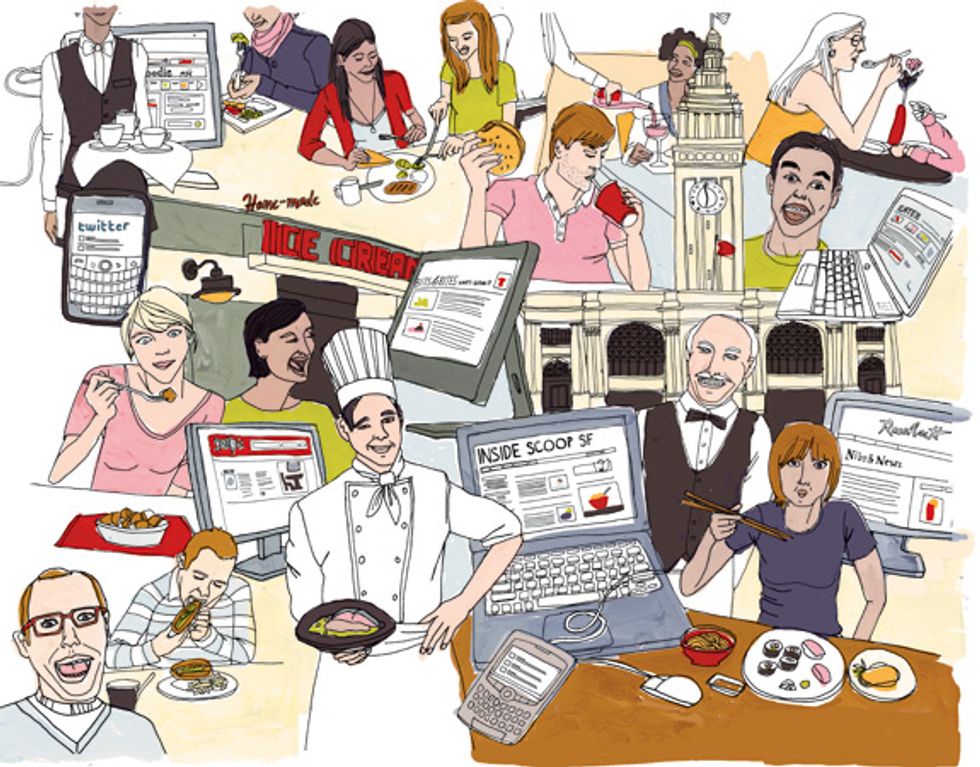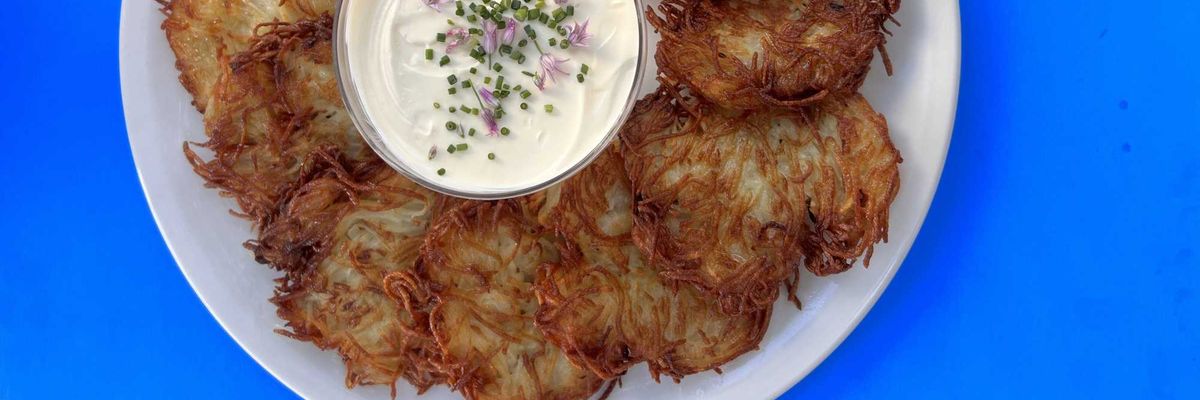With countless websites clamoring to cover the minutia of our restaurant scene, the city is suffering from a gluttony of food information. From Yelpers to tweeters to bloggers, the new world of media has both diners and chefs documenting dinner’s every detail. Is the pleasure of food is getting lost in the mix?
5:11 a.m. Dogs get fat from too much sugar too
8:17 a.m. Morning headlines
8:55 a.m. Wherein Anthony Bourdain stops by for a chat (24 re-tweets; 52 Facebook shares)
10:43 a.m. Benu school: The process behind Corey Lee’s custom porcelain and tableware
12:57 p.m. Staging at Alinea
2:01 p.m. Where’s the best takeout? 3:26 p.m. A bar star takes on Fillmore
3:30 p.m. Egyptian restaurant tries to find its way into the Marina
5:42 p.m. Evening headlines.
On one given Friday in June, these are the headlines for a mere 12 hours worth of food news on Inside Scoop SF—the Chronicle’s all-encompassing, restaurant news–focused blog that launched a few months ago, the savvy decision of longtime critic and food editor Michael Bauer. The site also has an aggregated “Chefs Feed”: Within 15 minutes’ time, I watch Four Barrel announce a new Guatemalan coffee; Lafitte link to their Zagat review; Comstock Saloon tweet about a shot of Four Roses bourbon; and chef Ravi Kapur link to a dim TweetPhoto of the yet-to-open Prospect space. The Scoop is also home to Bauer’s “Between Meals” blog and Jon Bonné’s daily thoughts on wine and spirits. To the left, an ongoing column dubbed “Voices” invites select local food industry folks to wax on about things like hospitality issues and $1,000 knives.
I click over to SF Weekly’s blog, SFoodie, to see that editor John Birdsall has reported that Mission Street Food founder Anthony Myint is opening Mission Chinese Food in July. Within the hour, the same information is repeated on Grub Street and Eater SF. (Birdsall later makes sure to let me know that he technically had the scoop for weeks, but, at Myint’s request, had kept it under wraps.) In the early evening, Inside Scoop reports the story briefly, linking it back to Birdsall’s original article. Paolo Lucchesi, the Scoop’s main gossip and news columnist, who was hired away from Eater, takes seriously the courtesy of crediting the original news source—something, he grumbles, not every blogger is inclined to do. “Not that it matters,” he says, checking himself. “This ain’t Watergate.”
Maybe not, but the pure amount of information unfolding by the minute on the Internet has created a frenzy that can make a food editor’s heart race like they’ve had one too many espressos. By my count, including 7x7’s own Bits + Bites, there are currently at least seven major sites—from Grubstreet to Bay Area Bites to Tablehopper—whose sole mission is to report on the minutia of SF’s restaurant scene. There are forums such as Yelp and Chowhound, as well as dailies such as Tasting Table, Daily Candy, Thrillist, Urban Daddy and most recently Blackboard Eats, which offers deals from restaurants. More restaurant news can be found on SFist, SF Appeal and neighborhood-centric sites such as Mission Mission. Add to that the pastime of Foodspotting and Foursquaring; personal blogs such as Food Fashionista; Facebook fan groups; and oh, yeah, Twitter. Chefs rack up followers. Tyler Florence has some 188,000.
Marcia Gagliardi, now known simply as “The Tablehopper,” started her career with an e-newsletter. Four and a half years later, she’s published a restaurant guidebook. “It’s funny,” she says. “When I started Tablehopper, it was to primarily cover restaurants that weren’t getting covered in print media. Now it’s a little exhausting how there’s this constant repetition of news in every outlet. It makes it harder to keep my content fresh.”
But should you think we’ve reached our threshold, this summer, NBC’s Feast—a site about “eating, shopping and playing”—is launching its SF version. Ben Leventhal, Feast’s NYC-based managing editor of lifestyle content, has some perspective on this whole game. He cofounded Eater in 2005 and remains a stakeholder. “I think San Francisco is as good a food city as there is in the country,” he says, “and cities like New York certainly are an indication that a huge amount of food coverage can be supported by consumers and advertisers.” To differentiate itself, Feast features restaurant listings powered not by one human voice but by “Feast ranks,” which pulls in reviews from hundreds of sources, using a combination of critical attention and buzz to come up with a 1–100 composite score.
My job is to keep up with SF’s food news, so I’m both blessed by this phenomenon and cursed. Blessed because I could eat in for the rest of my life and still know more about the restaurant scene than I’ve learned in my entire 15-year career as a food writer. Every day, I discover something new. Meesha Halm, the longtime editor of our local edition of Zagat, echoes this. “It’s great because there’s an army of people on the street blogging about restaurants before they open. It’s an easy way to keep my finger on the pulse.”
It also makes for a case of FADD (food attention deficit disorder). I regularly find myself staring blearily at my computer, going from one site’s smogasbord to the next—derailed in a moment of weakness by things like a Daily Mail post pondering whether or not three-Michelin-starred English chef Heston Blumenthal will indeed be serving the Queen of England testicles for a royal supper. It is at that point—just when I’m feeling the flush of indignation or at the very least the need to pour myself a double Scotch—that a quote from Anthony Bourdain reverberates in my head: “I think the blogosphere is the future. It’s agonizing to watch the established food media try to deal with that. It’s like watching your grandparents trying to break-dance.”
Of course, there are some very positive things about this brave new world of food information, where there is now a true democratization of opinions on an activity that, let’s face it, everyone is born doing. “The playing field has been leveled,” Bauer says about his job as a reviewer. Eleanor Bertino, a longtime SF-based restaurant publicist, agrees. “It’s nice to get more opinions than from just one or two powerful critics.”
The Internet’s viral quality is also a powerful and free publicity tool for small businesses that can’t afford $40,000 a year for a PR agency. Anna Weinberg, owner of Marlowe in SoMa, had been struggling to bring in a lunchtime crowd to her Townsend Street location. “Turned out all I needed was a great burger on the menu, because that kind of information gets picked up and is regurgitated so many times by bloggers,” says Weinberg. People without permanent spaces, such as butcher Ryan Farr of 4505 Meats, have made their names using blogs and Twitter as platforms. “It’s been a great way to reach out to customers,” Farr says. “It’s kind of corny, but it actually creates a bigger connection.”
On the flip side, chef Chris Kronner of Bar Tartine voices a common complaint. “One reviewer came in two weeks after we opened and posted shitty pictures he had taken and wrote negative things and it was like, ‘Thanks dude.’ He’s also written other things without fact checking it,” Kronner says. “So, false information is an issue.”
Immediacy is ideal for those tweeting about an hourly food truck location, but
the pressure to play ball in an environment where Eater has “plywood reports” and Citysearch uses Facebook to request reader reviews the day a restaurant opens, requires tough judgment calls on a food editor’s part—not always the best. I’ve found myself more than once letting my food cool while I sheepishly get out my camera to snap a photo of my dinner for 7x7’s blog. Bauer even admits: “I sometimes wonder if I shouldn’t be waiting a month before I start doing visits. Some people say it’s not enough time, but some people have Yelpers in during friends-and-family meals to review.”
Yelpers have become infamous for rushing to get the “First to Review” status on a place—often whether they’ve eaten there or not. Kronner recounts a story that his friend, winemaker-of-the-moment Andrew Mariani, told him about a wine dinner he held in Napa that was attended by several Yelpers. “They were yelling out, ‘Susie’s FTP!’ Or first to post,” explains Kronner. “Were they actually paying attention to the cool experience they were having or were they more concerned with posting first to Yelp? It’s ridiculous.”
Sometimes chefs get caught up in the maelstrom, too. For one of Inside Scoop’s “Voices” blogs, Hapa Ramen owner Richie Nakano wrote a humbling account of what happens when a chef tweets too much. In May, Nakano largely used Twitter to get out the word about his ramen trial run at Coffee Bar before launching his stand at the Thursday Ferry Plaza Farmers Market. He wrote: “The swell starts to build, and all at once I’m excited, and nervous, and sick to my stomach.” Tweets referencing @haparamen say things like “Can’t wait!” But the one that catches my attention says this: “How can @haparamen possibly live up to the hype?” That evening, more than 500 people showed up. Some waited four hours; some were very angry. In blog comment boxes, expletives were exchanged.
Nakano might have gotten his noodles handed to him, but he can’t take all the blame. The debacle was partly caused by people who were willing to wait for hours for ramen they’d never had—the enablers. Since the invention of sun-dried tomatoes, this city has been passionate about its eating habits, but the social media hype has created a culture that celebrates an I-ate-it-first status, making for lines out the door. Tweeting to let the world know that you’re 70th in line at the American Grilled Cheese Kitchen isn’t considered insane—it’s considered dedicated.
What used to be considered industry news is now fodder for everyone. Catapulted to stardom by shows on the Food Network and Bravo, chefs are followed like US Weekly celebrities, their every move documented. Gail Shifman is a criminal defense lawyer who follows Tablehopper and more. “I get Eater. SFoodie. I’m a busy professional who has a passion for awesome food. Now I’m getting information about everything from where the pig comes from to who’s butchering it. It can be a bit much, honestly.”
Being in-the-know is a sort of social currency in a town where dining is one of the main forms of entertainment. “My role among my friends is to know the newest restaurants,” Shifman says, adding that she had a date set to eat at Wayfare Tavern before it had even opened.
Gagliardi calls this “food adventuring.” Others might call it being a foodie. “I want to take the i.e. out of foodie!” says Bertino, who longs for the days when people just enjoyed dinner conversation, rather than making the dinner itself the conversation. “I hate it. Everything here has to become another commodity, another fetish. It takes the pleasure out of it.”
Maybe this is the inevitable result of the perfect storm in a city whose deepest interests lie in food and technology. In explaining why he launched Inside Scoop, Bauer echoes this: “Hearst [the Chronicle’s parent company] wanted to go deep into different industries. In Houston, they did oil and gas. In San Antonio, the military. Here, I think anyone who looks at San Francisco thinks of food. It’s our city’s strength.” But can we sustain this hype or will some blogs soon be on what Eater once coined ‘Death Watch’?
“Hopefully all the competition does is makes everyone better,” Bauer says. “But in an ideal world, the person who’s best will end up on top.” Foodies, start your engines.
The Delfina Drama: Back in April, local food bloggers got wind of Delfina’s potential plans to open a new restaurant. The switchboards lit up, and the chef took advantage of the rumor mill.
April 1. SFGate.com’s Inside Scoop reports that Delfina chef Craig Stoll is looking to open a new restaurant in a “gem of a location,” concluding, “It’s in the Mission District. Let the rumor-mongering commence.”
April 1, 1:40 p.m. Grub Street San Francisco chimes in, wondering if “Stoll might be aiming for some kind of midrange Mexican concept … Feel free to take guesses of your own, or to drop us your anonymous tips.”
April 2, 4:55 p.m. Grub Street San Francisco follows up with a rip that Stoll’s new location will be in Pac Heights, not the Mission: “The tipster also tells us hiring for the new restaurant’s staff has already begun. Is this plan in addition to the aforementioned non-pizza venture in the Mission? Or were the facts just wrong about the Mission location?”
April 3, 8:07 a.m. @CraigStoll fans the flames, tweeting, “Waitin here at SFO for our flight to Mexico for a little R&D … Did I say that? I meant R&R.”
April 14, 1:44 a.m. Mission Mission proudly proclaims, “Well, we solved the mystery. The deal is done, and [the Stolls’ new location is] Ramblas, home of somewhat affordable tapas and sangria and organic pale ale, on Valencia between 16th and 17th.”
April 14, 9:30 a.m. Grub Street San Francisco references Mission Mission’s scoop about the location and moves on to the topic of genre: “Given the penchant of high-end chefs in the area to try their hand at regional or non-taqueria-style Mexican food … we’re sticking to our original guns that Stoll is hitching a ride on the Rick Bayless wagon.”
April 14, 1:07 p.m. SFWeekly’s SFoodie tries to get Stoll’s wife and co-owner Annie to confirm the rumors, but she refuses. “Could the Stolls be planning some Nopalito-like concept for Valencia?”
April 14. Eater SF repeats the Ramblas news.
April 14, 2:26 p.m. 7x7 Magazine: Bits + Bites interviews Craig Stoll, confirms the location and learns that the new restaurant is “going to be Roman … unless it’s not … Locanda is the working word. It’s translates to gathering place. But it might be Locanda something-something.”
April 14, 4:45 p.m
. SFWeekly’s SFoodie references the 7x7 interview, repeating: “Craig Stoll’s Roman-inspired Locanda (a working name) is expected to open late spring or early summer in the Valencia space that’s now Ramblas.”
Epilogue May 14, 1:10 a.m. @CraigStoll lobs one final tease to the bloggerati: “On the way to Rome for some R&D. Really.”
Illustrations by: Julia Rothman






















